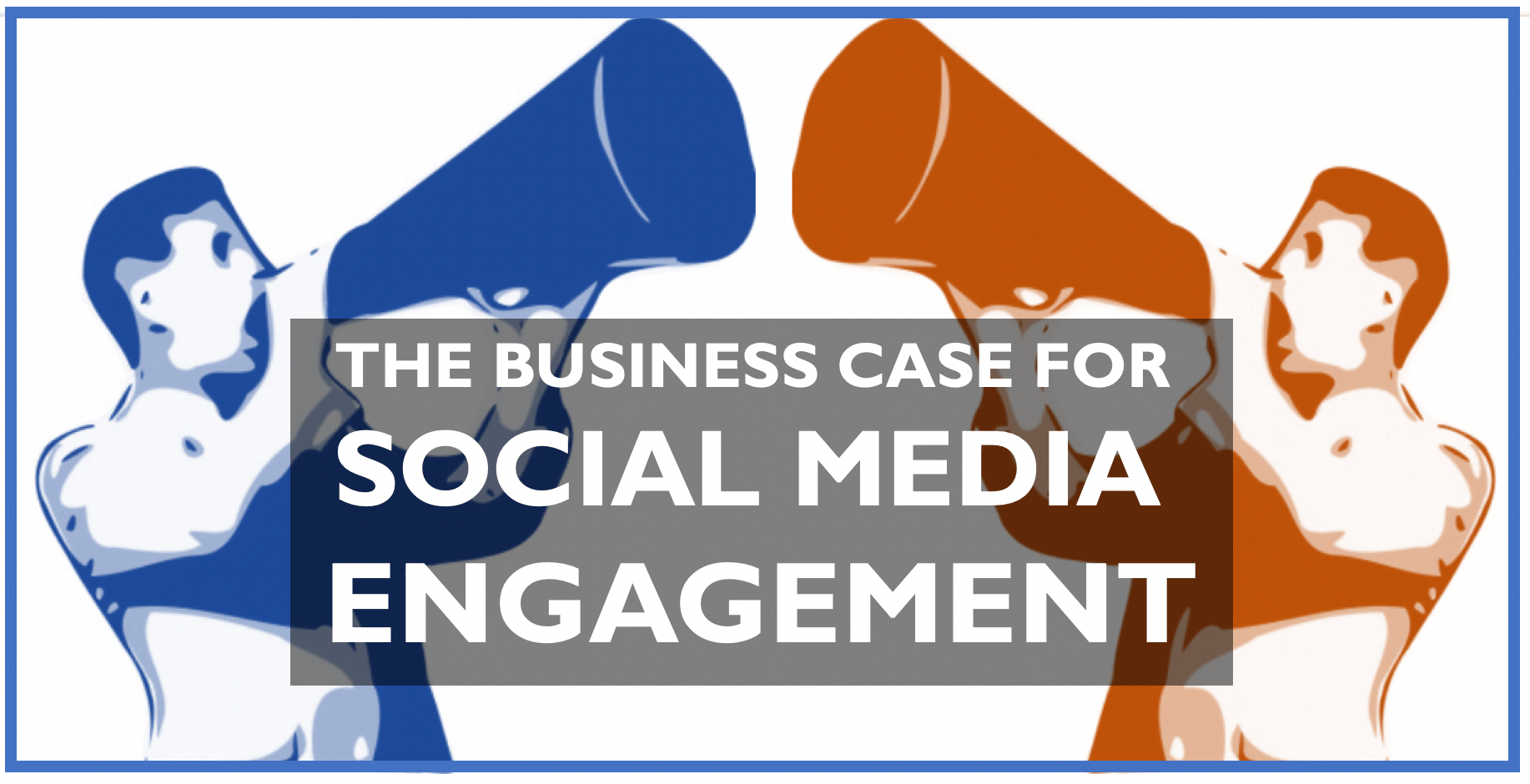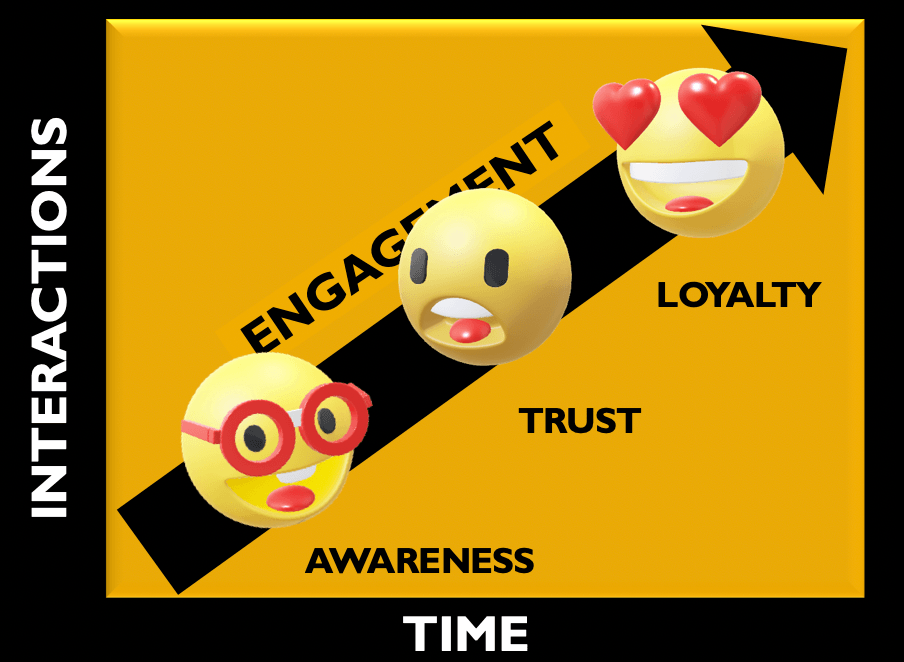
One of the go-to marketing metrics is social media engagement. It just makes sense. If people are engaging with our content through likes, shares, and comments, that seems like a reasonable precursor to valuable business benefits. And it’s so easy to measure, which is always welcomed!
But as I was doing research for my latest book, I could not validate that hypothesis. There is literally no reliable research that ties social media engagement to tangible financial benefits. We may “feel” it makes a difference — more engagement is better — but is it?
What is a rational, data-based view of the true value of engagement to our businesses? In this comprehensive post, I expand on eight conclusions about the economic value of social media engagement:
- Customer engagement is not normally connected to brand loyalty.
- Most social media engagement does not lead to short-term financial benefits.
- Social sharing is an important metric because it represents organic advocacy.
- Social media engagement that leads to customer community can create tangible business benefits.
- Social media engagement may open opportunities to actionable new business relationships.
- Engagement can improve content reach efficiency and promotional costs.
- Social media engagement has value when it encourages the right organizational discipline.
- Many new customers are “lurkers” who never engage.
The economics of social media engagement
Before I get into these eight conclusions, let’s step back and define social media engagement and its role on the web.
 Social media engagement means a human interaction or conversation spurred by content: a like, comment, conversation stream, or social share would be examples.
Social media engagement means a human interaction or conversation spurred by content: a like, comment, conversation stream, or social share would be examples.
Posting a blog post, infographic, or video is not engagement. That is broadcasting. Automated responses or cut-and-paste LinkedIn invitations are not engagement either. Typical social media engagement would be:
- Responding to public and private comments
- Answering direct questions on places like Twitter and LinkedIn
- Actively liking, commenting, sharing content
It’s certainly possible to be massively successful without social media engagement. The most valuable brand in the world, Apple, has no social engagement. Seth Godin, the most famous guru in the marketing space, never participates in the web.
Social media engagement can be an economic burden. It requires a tremendous amount of time and effort to engage on the web, soaking up resources that could otherwise be directly producing revenue. In 2014, I received so many comments on one blog post (Content Shock), that keeping up with the social media frenzy drove my business into the ground for three weeks.
You can engage yourself broke.
So this is an important question to consider as part of every digital marketing strategy: Does social media engagement create measurable business benefits?
Let’s answer that today.
A single study on engagement
The only thing close to an academic study I could find was published in the Harvard Business Review several years ago (this is featured in Chapter 6 of Marketing Rebellion). The research showed that there was no correlation between social media engagement and brand loyalty.
So that puts a dent in the works, doesn’t it?
I often say that a “like” has the same value as somebody waving at you. It’s a nice gesture, but it doesn’t mean they’re going to buy something or even come back again some day.
Conclusion Number One: Research shows customer engagement does not normally establish brand loyalty.
Show me the money
There was another interesting insight from a different HBR post, however. This would not necessarily count as an academic study, but it does reveal a sensible observation.
A founder of the Community Roundtable suggests there are four types of social media engagement:
- Validate — Includes liking, commenting, bookmarking, or responding to posts. This is often the first visible behavior beyond consuming that people exhibit … sort of the equivalent of dipping their toes in the water to assess whether the social environment is comfortable.
- Sharing — Sharing documents, graphics, updates, and ideas. People start with sharing content that has been written by someone else. As they feel validated and connected to a group, they are more likely to share their own observations and ideas.
- Asking and Answering Questions — Individuals tend to start with logistical questions (“where can I find x?”) and if they find the culture to be supportive and trustworthy they will ask deeper questions (“what is the best way to manage a customer situation?”).
- Exploring — This includes open-ended questions or questions about ambiguous topics where there is no right or known answer. This requires individuals to feel like the community culture is both supportive and challenging, making it a safe space to explore, admit vulnerability, and share incomplete ideas. This stage is where rich collaboration and innovation takes place.
Here’s where it gets interesting. The researchers found that the question-and-answer category can indeed be tied to some financial benefit. When people start solving each other’s problems, it saves the company money.
But getting to that point of trust takes a lot of work and time. Most individuals need to feel comfortable and connected before they are willing to ask a question that might make them feel vulnerable.
For this reason, the ROI of engagement is typically negative until the culture supports and rewards regular asking and answering within a trusting community. This suggests that this very specific type of engagement holds value.
Conclusion Number Two: Most social media engagement does not lead to short-term financial benefits. However a trusting brand community that is asking and answering questions can provide a positive and measurable ROI.
The social share: Entering a conversation
Social sharing is a unique form of engagement and among the most important metrics in the digital space (second only to conversions to sales.)
Increasingly, consumers do not trust businesses, brands, or advertising. But we trust each other.
Social sharing is critically important to any digital marketing effort because it represents organic advocacy. When people share your post, it is a very big deal! It is a sign that they trust you. It is a symbol that a person believed in your content so much they made it part of their own story.
Social sharing means your content is entering the public conversation. And in this world where the hyper-empowered consumer is in control, there is no more important achievement for a marketer.
The economic value of content that is not seen and shared is zero. So every digital marketing department must build an internal competency on content ignition.
While social sharing is undeniably important, it requires a measurement leap of faith. What happens to brand loyalty or your sales when a story starts to spread? It’s difficult (or impossible) to absolutely attribute the spread of a story to the click of a sale. But that doesn’t mean we shouldn’t do it.
Conclusion Number Three: Social sharing is among the most important digital marketing metrics. It represents valuable organic consumer advocacy yet may be difficult to tie to specific financial results.
Engagement leads to community
I recently proposed a new strategic framework for social media marketing. While social media engagement typically produces only weak relational links, done well, it can drive people to subscribe to our content. As a subscriber to a blog, podcast, YouTube channel, etc. the consumer has now opted-in to our marketing. In a virtual way, they are saying, “I like what you’re doing here. Send me more.”
Unfortunately, that’s where most companies stop. As I explained in Belonging to the Brand, the most powerful emotional brand connections are occurring in brand communities, which have historically been relegated to a role of customer self-service. Considering community as a brand-building strategy is the most over-looked opportunity in the history of overlooked opportunities.
So while social media engagement on its own has weak financial benefits, if it can drive customers into a community, you’re on to something big.
One example is the video platform Wistia. The Boston company provides a Slack channel membership to its customers that allows them to contribute, comment, solve problems, and even help develop new products and services. The Wistia community is magical and an example of an effective driver of loyalty in a world where most people shop around from service to service.
A brand community is sort of an alternative marketing universe. Engagement in the social media space is primarily a vanity metric, but within a brand community, it is definitely a sign of progress, vitality, relevance, and a leading indicator of future advocacy and sales!
Conclusion Number Four: Social media engagement that leads to an engaged customer community is an invaluable asset in a world of declining customer loyalty.
The actionable audience: Adding the human element
There is no value to social media engagement if it is simply accumulating on your company dashboard. However, you can create business benefits if you go the extra step to turn a passive social media audience into an actionable one. Here is a chart I use in many of my classes:

This chart represents the marketing hopes and dreams of every business. Over time, you want to create some type of customer interaction or provocation that leads to more and more business benefits.
Problem is, the benefits don’t start happening until you reach at least the middle of the line. Simply posting on social media is great for increasing awareness, but it normally requires a little something extra to move people from being a weak relational link at the bottom of the chart to the loyal super-fan at the top.
And that’s where social media engagement can help.
Here’s an example. A few years ago, a woman posted a picture on Twitter. She had lined up all of my books on her couch and exclaimed “I am Mark Schaefer’s biggest fan!”
I had never heard from this person before, but I was so touched by the photo that I called her up out of the blue. This was the beginning of a long bond and friendship that has definitely led to quantifiable financial benefits.
The lesson is, in most companies, this comment would have been buried in a chart. But I went beyond the dashboard and added a human element to the relationship. I turned a weak relational link into a strong, actionable bond through a simple phone call. My fan would have stayed at the bottom of the chart without my engagement.
You might be wondering … how is that scalable for a big brand?
I think it is. Every year, Taylor Swift surprises her fans with Christmas gifts. Not every fan, but enough to create a viral story and strong fan love for the way she connects in a sincere, human, and meaningful way. Taylor has more social media followers than any Fortune 500 company. If she can do it, you can do it.
Conclusion Number Five: Social media activity alone doesn’t lead to financial benefits unless you turn weak relational links into an actionable audience through long-term engagement.
Engagement can help improve organic reach and lower ad costs
Social media engagement might be important if you are investing ad dollars as part of your marketing strategy.
As far as the Facebook algorithm is concerned, engagement is a catalyst for increased reach. Getting good organic reach helps your content get elevated in the queue of the newsfeed to reach more people, including those who already like your Page.
Leveraging the organic momentum on posts and content can help keep your ad costs more predictable and stable – resulting in a more efficient spend of your marketing dollars.
The analogy I use is that it is easier to add fuel to a burning fire to make it bigger. The engagement is the fire, the fuel is your ad spend. If you are trying to fuel (add budget) to content that has no engagement (fire) then you’re not using your ad spend as efficiently as you could be.
Conclusion Number Six: Engagement might improve content reach efficiency and lower promotional costs.
Social media engagement is critical at the beginning
So far, we’ve concluded that social media engagement provides sketchy financial returns at best. But there is one period in a company’s lifespan where engagement is critical.
An annual study by Social Media Examiner showed that even in the early days of a company’s marketing effort, 85 percent of respondents reported an increase in awareness from a social media effort.
But just 30 percent reported a financial benefit in that first year. This means if you start with a goal to increase sales in Year One, you’re probably setting yourself up to fail.
A more appropriate metric in the first 1-2 years of a social media effort is engagement. I know that sounds fluffy, but hear me out.
Beginning an effective social media journey probably represents a significant cultural shift for a company. In my mind, just showing that you are DOING IT consistently and making progress is an achievement.
For a social media newbie, I like using engagement as an inital metric because it drives the right organizational changes. To have people engage with your content, you need to:
- Create content worthy of engagement
- Connect to people who are likely to engage
- Reward and encourage the people who engage
Those are the right behaviors for a company’s long-term social media success. It is also an easy way to see quick wins which encourages the new marketing program.
Conclusion Number Seven: Social media engagement is a useful metric in the first 1-2 years of a program because it encourages the right organizational marketing discipline.
The thunderous value of zero engagement
In this article, I’ve provided a rational view of what social media engagement can and cannot deliver.
I’d like to conclude this post by making the case that having an effective social media presence is critically important to your business, even if you have no engagement whatsoever.
When somebody hires me for a speech, workshop, or consulting assignment, I always ask them how they heard about me. Most of the time, they say “I’ve followed you for years.”
Silently.
Nearly every time, I have never heard of the person before … they’ve never engaged with me. There are powerful business opportunities in social media stalkers.
Nielsen published an often-cited 90-9-1 rule of engagement. It said that you can expect a community or network to have 90 percent of its members lurking/reading, 9 percent contributing, and 1 percent creating. Other research shows that an established and well-managed community can break down into 50 percent lurkers, 23 percent contributors, and 27 percent creators,.
Point is, even if you are doing an astounding job establishing community engagement, most of your best fans are still lurking in the background.
That’s why most of my business comes from lurkers. Just because they don’t engage with us doesn’t mean they’re not building trust in us. Speaking for myself, I might love a brand but never engage. Some people just want to be left alone!
Conclusion Number Eight: Social media engagement is a popular metric … but nearly all of your future customers are probably never engaging with you at all.
Social Media Engagement — Conclusion
Loyalty is in decline in almost every business category. McKinsey points to a lack of emotional connection as a primary reason for this trend.
Social media engagement is a way to establish the first emotional human connection between brands and their customers. It can provide undeniable benefits like awareness, organic advocacy, and a step toward community. However, connecting day-to-day engagement with these longer-term business benefits and financial goals is challenging … perhaps even non-existent.
Social media engagement is also the metric that is most easily gamed, as we see in the influencer space.
I saw a meme the other day of a person widely swinging whips around and the meme was “marketing managers trying to increase social media engagement.” You know a metric is in trouble when it starts to become a meme! it’s not going to help the credibility of the profession when we’re not aligned with business goals.
Moving from familiar, quantifiable measures on a social media dashboard to less quantifiable brand measures like stronger long-term customer relationships and loyalty requires leadership and a certain amount of faith. However, a human-centered approach to marketing also represents one of the few strategies we have left to differentiate ourselves in a noisy world.
I hope you’ve benefitted from this analysis, but I know there are a lot of ideas and wisdom that I missed. Would you consider engaging with this post and letting me know your thoughts?
 Mark Schaefer is the executive director of Schaefer Marketing Solutions. He is the author of some of the world’s bestselling marketing books and is an acclaimed keynote speaker, college educator, and business consultant. The Marketing Companion podcast is among the top business podcasts in the world. Contact Mark to have him speak at your company event or conference soon.
Mark Schaefer is the executive director of Schaefer Marketing Solutions. He is the author of some of the world’s bestselling marketing books and is an acclaimed keynote speaker, college educator, and business consultant. The Marketing Companion podcast is among the top business podcasts in the world. Contact Mark to have him speak at your company event or conference soon.


